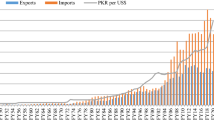Abstract
This paper investigates and compares the response to the exchange rate changes of trade balances of three Turkish sectors; agriculture, manufacturing and mining. The impact on trade balance of exchange rate changes is examined using the trade balance model employed in Bahmani-Oskooee [1985, Review of Economics and Statistics 67: 500]. Analysis is conducted based on the quarterly data from 1986: I to 1998: III. It is observed that in response to domestic currency depreciation trade balance of each of all three sectors first improves, then deteriorates and then improves again. Despite exhibiting similar pattern of reaction to the exchange rate change in the short run, long-run or overall response of trade balance differs across the sectors; while trade balances of both manufacturing and mining improve in the long run, agricultural trade balance worsens as a result of domestic-currency depreciation.
Similar content being viewed by others
References
Akbostanci E. (2004). Dynamics of trade balance: the Turkish J-curve. Emerging Markets Finance and Trade 40: 57–73
Almon S. (1965). The distributed lag between capital appropriations and expenditures. Econometrica 33: 178–196
Bahmani-Oskooee M. (1985). Devaluation and the J-curve: some evidence from LDCs. Review of Economics and Statistics 67: 500–504
Bahmani-Oskooee M. (1989). Devaluation and the J-curve: some evidence from LDCs: errata. Review of Economics and Statistics 71: 553–554
Bahmani-Oskooee M., Malixi M. (1992). More evidence on the J-curve from LDCs. Journal of Policy Modeling 14: 641–653
Brada J.C., Kutan A.M., Zhou S. (1997). The exchange rate and the balance of trade: the Turkish experience. Journal of Development Studies 33: 675–692
Carter C.A., Pick D.H. (1989). The J-curve effect and the US agricultural trade policy. American Journal of Agricultural Economics 71: 712–720
Dornbusch R., Krugman P. (1976). Flexible exchange rates in the short run. Brookings Paper on Economic Activity 7: 537–575
Doroodian K., Jung C., Boyd R. (1999). The J-curve effect and US agricultural and industrial trade. Applied Economics 31: 687–690
Himarios D. (1989). Do devaluation improve the trade balance? The evidence revisited. Economic Inquiry 27: 143–168
Junz H.B., Rhomberg R.R. (1973). Price competitiveness in export trade among industrial countries. American Economic Review 63: 412–418
Magee S.P. (1973). Currency contracts, pass-through, and devaluation. Brookings Papers on Economic Activity 1: 303–325
Meade, E. E. (1988). Exchange rates, adjustment, and the J-curve. Federal Reserve Bulletin, pp. 633–644.
Miles M.A. (1979). The effects of devaluation on the trade balance and the balance of payments: some new results. Journal of Political Economy 87: 600–620
Rose A.K. (1990). Exchange rates and trade balance: some evidence from developing countries. Economics Letters 34: 271–275
Rose A.K., Yellen J.L. (1989). Is there a J-curve. Journal of Monetary Economics 24: 53–68
Singh T. (2002). India’s trade balance: the role of income and exchange rates. Journal of Policy 24: 437–452
Wilson P., Tat K.C. (2000). Exchange rates and trade balance: the case of Singapore 1970 to 1996. Journal of Asian Economics 12: 47–63
Author information
Authors and Affiliations
Corresponding author
Rights and permissions
About this article
Cite this article
Yazici, M. The Exchange Rate and the Trade Balances of Turkish Agriculture, Manufacturing and Mining. Qual Quant 42, 45–52 (2008). https://doi.org/10.1007/s11135-006-9035-5
Accepted:
Published:
Issue Date:
DOI: https://doi.org/10.1007/s11135-006-9035-5




